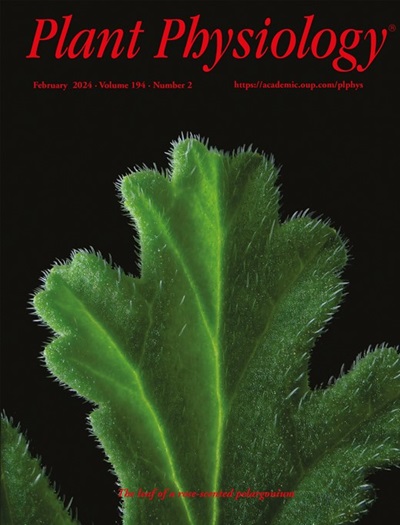水稻转录因子S40-14调控叶绿体和ros相关基因网络,促进黑暗诱导的叶片衰老。
IF 6.5
1区 生物学
Q1 PLANT SCIENCES
引用次数: 0
摘要
叶片衰老触发主要的代谢变化,循环资源,确保植物生存,对环境条件敏感。在这项研究中,我们利用CRISPR/Ca9突变体和过表达系对OsS40-14进行了表征,以研究其在水稻旗叶衰老中的作用。oss40-14突变体在黑暗处理下表现为叶片保持绿色,叶绿素和光合能力保持不变,活性氧(ROS)水平降低。而OsS40-14过表达系叶片衰老加速。对暗处理后的旗叶样本进行转录组分析发现,1585个oss40-14与WT的差异表达基因在大分子代谢、光合作用和胁迫响应中富集。此外,使用gfp标记的OsS40-14进行tsCUT&Tag-seq分析发现,2311个基因组位点与OsS40-14结合,约40.95%的结合信号富集在转录起始位点。OsS40-14的一致结合基序为TACCCACAAGACAC,种子序列为“ACCCA”。最后,对转录组和tcut & tag -seq数据集的综合分析显示,153个oss40 -14靶向候选基因包括66个在质体组织和光合过程中富集的潜在抑制基因,以及41个与胁迫信号传导和衰老相关的推测激活基因。综上所述,OsS40-14调控了水稻发育衰老和黑暗条件下的光合机制和ROS稳态,从而加速了水稻叶片衰老,减少了光合同化和籽粒灌浆。本文章由计算机程序翻译,如有差异,请以英文原文为准。
The rice transcription factor S40-14 regulates chloroplast and ROS-related gene networks and promotes dark-induced leaf senescence.
Leaf senescence triggers major metabolic changes that recycle resources and ensure plant survival and is sensitive to environmental conditions. In this study, we characterized OsS40-14 using CRISPR/Ca9 mutants and overexpression lines to address its function in rice (Oryza sativa) flag leaf senescence. The oss40-14 mutants displayed a stay-green leaf phenotype under dark treatment, with preserved chlorophylls and photosynthetic capacity and reduced reactive oxygen species (ROS) levels. In contrast, OsS40-14 overexpression lines exhibited accelerated leaf senescence. Transcriptome analysis of dark-treated flag leaf samples revealed that the 1585 differentially expressed genes in oss40-14 vs WT were enriched in macromolecular metabolism, photosynthesis, and stress responses. In addition, tsCUT&Tag-seq analysis using GFP-tagged OsS40-14 revealed 2311 genomic loci bound by OsS40-14, with approximately 40.95% of the binding signal enriched at transcription start sites. The consensus binding motif of OsS40-14 was identified as TACCCACAAGACAC, with a seed sequence of 'ACCCA'. Finally, integrated analysis of the transcriptome and tsCUT&Tag-seq datasets revealed that 153 OsS40-14-targeted candidates comprised 66 potentially repressed genes enriched in plastid organization and photosynthetic processes, and 41 putatively activated genes associated with stress signaling and senescence. Overall, our results suggest that OsS40-14 fine-tunes the photosynthetic machinery and ROS homeostasis during developmental senescence and under dark conditions, thereby accelerating leaf senescence, reducing photosynthetic assimilation and grain filling in rice.
求助全文
通过发布文献求助,成功后即可免费获取论文全文。
去求助
来源期刊

Plant Physiology
生物-植物科学
CiteScore
12.20
自引率
5.40%
发文量
535
审稿时长
2.3 months
期刊介绍:
Plant Physiology® is a distinguished and highly respected journal with a rich history dating back to its establishment in 1926. It stands as a leading international publication in the field of plant biology, covering a comprehensive range of topics from the molecular and structural aspects of plant life to systems biology and ecophysiology. Recognized as the most highly cited journal in plant sciences, Plant Physiology® is a testament to its commitment to excellence and the dissemination of groundbreaking research.
As the official publication of the American Society of Plant Biologists, Plant Physiology® upholds rigorous peer-review standards, ensuring that the scientific community receives the highest quality research. The journal releases 12 issues annually, providing a steady stream of new findings and insights to its readership.
 求助内容:
求助内容: 应助结果提醒方式:
应助结果提醒方式:


